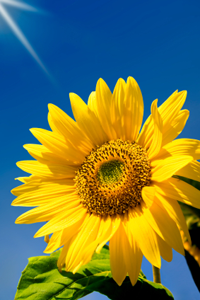Sunflower
 The botanical name is Helianthus. The Greek word “helios” means sun and “anthos” means flower. It is aptly named after the sun which it resembles.
The botanical name is Helianthus. The Greek word “helios” means sun and “anthos” means flower. It is aptly named after the sun which it resembles.
Description
Sunflowers have a large flower head, usually with a large, almost black central part which is made up of thousands of tiny florets that later become seeds set in a spiral pattern. The petals are typically bright yellow, although some varieties are orange or red. Its stem is rough and hairy while the leaves large and rough with coarse jagged edges. Sunflowers typically grow to between one and a half and three and a half metres, with some giant variants reaching up to eight metres.
Habitat
Helianthus originated in the Americas, where Native Americans grew it for years as a source of food. In line with its original habitat, it requires hot and dry conditions to thrive.
Availability
Sunflower seeds should be sown in fertile, moist, well-drained soil that contains heavy mulch. They need full sun to grow properly and develop best in summer. They thrive when grown in large clusters, as they shade the ground and keep the roots cool and the ground damp for longer. These groups afford protection from the wind and can help support each other.
Species
The sunflower belongs to the Asteraceae family, or Asters. There are 38 North American species of sunflower, some varying from the traditional yellow. Through hybridisation, there are now tan, orange, burgundy or striped petals varieties available as well. Bi-coloured ones such as the Prado Red have reddish-brown petals with yellow bordering.
The Giant Sunflower generally grows to about three metres. Recently, low-pollen species have been developed which help asthma sufferers.
Care Tips
Sunflowers are generally hardy plants and can withstand short dry or wet spells. It’s important that they are not overwatered, as this loosens the soil to the point that they cannot support the weight of the large flowers heads.
Seedlings need to be protected from snails until they are about ten centimetres high. Tall plants can be stabilised by tying individual plants to supporting sticks.
Did you know?
The Mexican Sunflower is smaller than the traditional variety and consists of practically all petals and no centre, as it is grown for ornamental purposes.
References
http://www.sunflowerguide.com/growing-sunflowers.html
http://www.gardenersworld.com/how-to/projects/fruit-and-vegetables/how-to-grow-sunflowers-from-seed/325.html
http://www.ask.com/questions-about/Sunflower-Habitat


